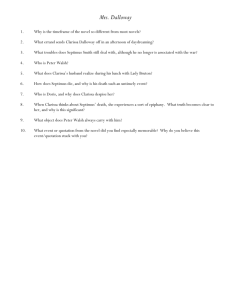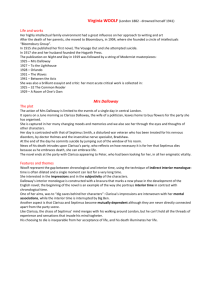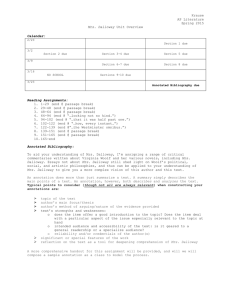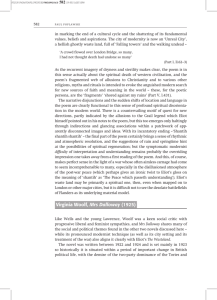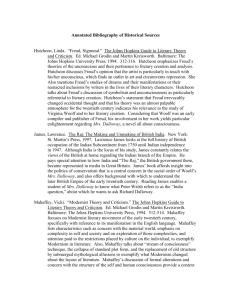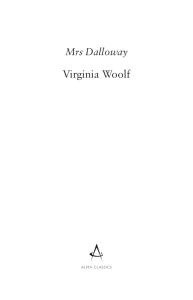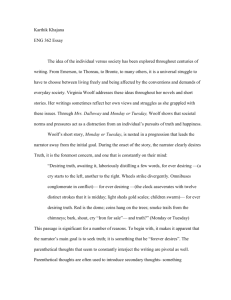Mrs Dalloway
advertisement
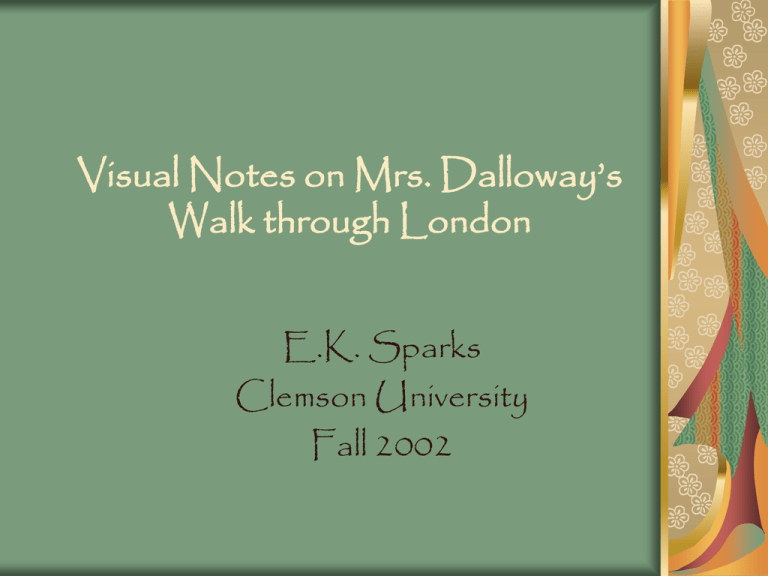
Visual Notes on Mrs. Dalloway’s Walk through London E.K. Sparks Clemson University Fall 2002 Woolf on the parallel structure "Suppose it to be connected in this way: Sanity and insanity. Mrs. Dalloway seeing the truth, Septimus Smith seeing the insane truth . . . The pace is to be given by the gradual increase of Septimus's insanity on the one side; by the approach of the party on the other. . . . The Question is whether the inside of the mind in both Mrs Dalloway and Septimus Smith can be made luminous--that is to say the stuff of the book-lights on it coming from external sources." Woolf’s “philosophy” "Perhaps this is the strongest pleasure known to me. It is the rapture I get when in writing I seem to be discovering what belongs to what; making a scene come right; making a character come together. From this I reach what I might call a philosophy; at any rate it is a constant idea of mind; that behind the cotton wool is hidden pattern; that we--I mean all human beings--are connected with this; that the whole world is a work of art; that we are parts of the work of art. Hamlet or a Beethoven quartet is the truth about this vast mass that we call the world. But there is no Shakespeare, there is no Beethoven; certainly and emphatically there is no God; we are the words; we are the music; we are the thing itself." Woolf on “character” "I believe that all novels begin with an old lady in the corner opposite. I believe that all novels, that is to say, deal with character, and that it is to express character--not to preach doctrines, sing songs, or celebrate the glories of the British Empire, that the form of the novel, so clumsy, verbose, and undramatic, so rich, elastic, and alive, has been evolved" (from her essay “Mr Bennett and Mrs Brown”). “Fear No More the Heat of the Sun” William Shakespeare’s play, Cymbeline (act 4, scene 2) contains a funeral song, sung while Guiderius and his brother strew the “fairest flowers” to “sweeten thy sad grave.” Fear no more the heat of the sun, Nor the furious winter’s rages, Thou thy worldly task hast done, Home art gone, and tane [taken] thy wages. Golden Lads, and Girls all must, As Chimney-Sweepers come to dust. The phrase is alluded to five times in the novel Clarissa recalls the words four times during the day: When she is looking in a bookstore window (9) When she learns that Lady Bruton and Richard are dining together (29) When she is sewing and remembers her youth with Peter (39) When she thinks about Septimus Smith’s death (182) Septimus Smith thinks of the words once During his moment of contentment before Holmes comes to take him (136) Social Analysis in Mrs. Dalloway “I want to critique the social system, and to show it at work at its most intense” – Virginia Woolf on Mrs. Dalloway Hugh Whitbread: “this type of an English public school man” (173) Prime Minister: “the symbol of what they all stood for, English society” (172) Peter Walsh: “the public spirited, British Empire, tariffreform, governing-class spirit.” Lady Bruton and Peter Walsh identify with Britain’s imperial mission Mrs. Dalloway’s Walk from Dean’s Yard, Westminster to Bond Street (MD 3-14) Westminster Abbey Archway to Dean’s Yard [Richard Dalloway] entered Dean’s Yard ... approaching his door: MDA 129 Big Ben (1910) Strikes 10:00 as Mrs. Dalloway crosses Victoria St. Birdcage Walk: Entrance to St. James Park “in the middle of St James’s Park on a fine morning” (MD 9) By the clubs on Pall Mall Burlington Arcade: across Piccadilly St from Bond St. Septimus & Rezia’s walk from Oxford St. through Harley St. to Regent’s Park (MD 14-27) Oxford Street, 1910 Regent’s Park: flower beds & fountains Regent’s Park: The Broad Walk Harley Street Peter Walsh’s Walk: Westminster, up Whitehall, through Trafalgar, up Regent’s St. to Regent’s Park (MD 48-56) Trafalgar Sq., 1908 Richard Dalloway’s Walk: Brook St. off New Bond, through Green Park, past Buckingham Palace into Dean’s Yard (MD 112-117) Buckingham Palace, 1910 Elizabeth’s Bus Ride: from Army Navy Stores on Victoria St. , up Whitehall and the Strand to Fleet Street (MD 134-139) Fleet Street looking towards St. Paul’s (1910) All the Dalloway Walks
